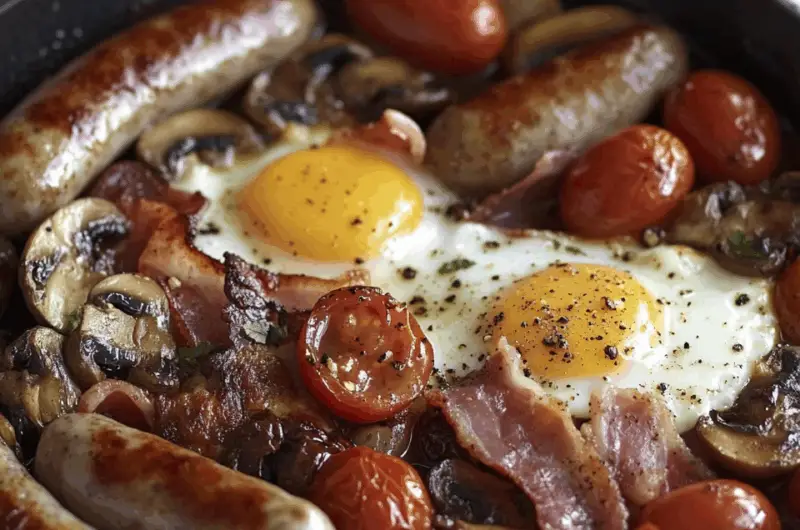The Full English Breakfast is a timeless meal that delivers warmth and satisfaction with every bite. The crispy bacon and sausages paired with perfectly fried eggs, tender mushrooms, and fresh tomatoes create a harmonious blend of textures and flavors. The comforting baked beans and buttered toast complete this iconic British feast, making it a breakfast experience that’s both indulgent and hearty.
This dish is ideal for lazy weekend mornings or any time you want a filling and nostalgic meal. Its versatility allows for tweaks like vegetarian versions or additional sides, but nothing quite beats the traditional combination that’s been enjoyed for generations. It’s more than just food—it’s a celebration of classic British breakfast culture.
Full Recipe:
-
2 pork sausages
-
2 rashers of smoked back bacon
-
2 large free-range eggs
-
4 slices of black pudding
-
4 large flat mushrooms, cleaned and trimmed
-
2 tomatoes, halved
-
1 can of baked beans
-
4 slices of white or brown bread (for toast)
-
Butter, for frying and spreading
-
Salt and freshly ground black pepper
-
Cooking oil
Directions:
-
Heat a large frying pan or griddle over medium heat. Add a little oil to the pan.
-
Add the sausages and cook for about 10-12 minutes, turning regularly until browned and cooked through.
-
While sausages cook, place the bacon rashers in the pan and fry for about 4-5 minutes each side until crispy.
-
In another pan or griddle, fry the mushrooms and tomatoes, seasoning lightly with salt and pepper. Cook mushrooms until tender and tomatoes until just softened.
-
Fry the black pudding slices for about 2 minutes each side until crisp.
-
Toast the bread slices and butter them generously.
-
In a clean pan, fry the eggs sunny side up or to your liking, seasoning with salt and pepper.
-
Warm the baked beans gently in a small saucepan.
-
To serve, arrange the sausages, bacon, eggs, black pudding, mushrooms, tomatoes, and baked beans on a large plate. Add the buttered toast on the side.
Prep Time: 10 minutes | Cooking Time: 20 minutes | Total Time: 30 minutes
Kcal: Approx. 700 kcal | Servings: 2 servings
The Enduring Appeal of the Full English Breakfast
The Full English Breakfast is much more than a meal—it’s a cultural institution, a comforting ritual, and a celebration of traditional British cuisine. Its generous portions and diverse ingredients make it an ideal choice for anyone looking to enjoy a substantial, flavorful start to the day.
While it may not be an everyday meal for many due to its richness, the Full English Breakfast holds a special place in hearts and menus worldwide. Whether you enjoy it as a weekend treat, a gathering centerpiece, or a culinary experience when traveling in the UK, this classic dish delivers warmth, satisfaction, and timeless appeal.
By appreciating its history, savoring its flavors, and adapting it thoughtfully, the Full English Breakfast remains a cherished dish that continues to unite food lovers with its hearty charm and unmistakable taste.
The History and Origin of the Full English Breakfast
The Full English Breakfast, often affectionately called the “Full English” or simply a “fry-up,” is one of the most iconic and enduring meals in British culinary history. Its roots stretch back several centuries, evolving from humble beginnings into the beloved classic it is today. Originally, this breakfast was a way for rural laborers and farmers to fuel up with a hearty meal before a long day of physical work. Over time, it became a staple for all classes and a symbol of traditional British fare.
The meal’s composition has changed slightly over the years, but the essentials have remained largely the same: sausages, bacon, eggs, mushrooms, tomatoes, black pudding, baked beans, and toast. Each item brings its own flavor, texture, and nutritional contribution, creating a well-rounded and satisfying dish. The tradition of serving these ingredients together has transcended generations, and today it’s enjoyed not only in homes but also in cafes and pubs across the UK and beyond.
Cultural Significance and Popularity
The Full English Breakfast holds a special place in British culture, symbolizing comfort, hospitality, and a slower pace of life. It’s often associated with weekends, holidays, and family gatherings, when people take time to enjoy a substantial meal rather than rushing through a quick bite. This breakfast is a celebration of local produce and classic cooking techniques, and it’s also a culinary experience that brings people together.
In the UK, it is common to find a Full English Breakfast offered on menus from the smallest bed-and-breakfast establishments to high-end hotels, as well as traditional pubs. It has also become an ambassador of British cuisine internationally, often featured in travel shows and food festivals. The hearty nature of the meal appeals to those who appreciate indulgence and nostalgia, and it continues to attract both locals and tourists.
Nutritional Value and Health Considerations
While undeniably delicious, the Full English Breakfast is also a meal that requires some consideration regarding nutrition. It’s generally rich in protein, fats, and calories, providing substantial energy, especially for those engaged in physically demanding activities. The combination of eggs, bacon, and sausages contributes a significant amount of protein, which is essential for muscle repair and growth.
However, the dish can be high in saturated fats, sodium, and cholesterol, especially when using processed meats like sausages and bacon. Black pudding, although rich in iron, is also high in fat and salt. The inclusion of baked beans adds fiber and some sweetness, balancing the plate with a vegetable element, while mushrooms and tomatoes provide vitamins and antioxidants.
For those watching their calorie intake or aiming for a healthier lifestyle, there are ways to modify the traditional Full English Breakfast. Opting for grilled rather than fried items, choosing leaner meats or vegetarian alternatives, and adding extra vegetables can help create a more balanced plate without sacrificing flavor.
Variations Across the UK and Beyond
Although the Full English Breakfast is the best-known version, different regions of the UK and Ireland have their own variations on this theme. In Scotland, for instance, you might find “lorne sausage” or square sausage as part of the breakfast. In Wales, laverbread (a type of seaweed paste) sometimes makes an appearance alongside the usual suspects.
Across Ireland, the “Full Irish Breakfast” closely resembles the English version but often includes additional local favorites like soda bread or potato farls. In Northern Ireland, white pudding is commonly served alongside black pudding.
Internationally, the concept of a hearty breakfast with multiple components has inspired adaptations in other countries, from American diner breakfasts to Australian brunch culture, each incorporating local tastes and ingredients but retaining the spirit of a satisfying, full meal.
Tips for Preparing the Perfect Full English Breakfast
Achieving the perfect Full English Breakfast requires some attention to timing and technique. Because the meal involves multiple components cooked separately, coordinating the cooking process is key to serving everything hot and fresh.
Start with the sausages and bacon, as they generally take the longest to cook. Fry or grill them until they reach the ideal crispiness and juiciness. Mushrooms and tomatoes should be cooked until just tender but not overdone, preserving their freshness and flavor. Black pudding slices need a short, hot sear to crisp up without drying out.
Eggs can be cooked according to personal preference—whether fried sunny-side-up, scrambled, or poached—but timing is critical to ensure they remain warm and runny. Toast should be done last and buttered immediately to maintain its texture and warmth.
Using quality ingredients makes a huge difference. Opt for free-range eggs, locally sourced meats, and fresh vegetables whenever possible. Not only does this improve taste, but it also supports sustainable and ethical food practices.
Why the Full English Breakfast Remains a Favorite
The enduring appeal of the Full English Breakfast lies in its combination of nostalgia, comfort, and flavor. For many, it recalls childhood memories or the cozy atmosphere of a country inn. The dish’s hearty, satisfying nature makes it perfect for colder mornings or as a weekend treat.
Unlike many modern breakfasts that focus on speed or minimalism, the Full English Breakfast invites people to slow down, savor their food, and enjoy a communal dining experience. It’s flexible enough to suit different tastes and dietary needs, allowing for adaptations without losing its identity.
Moreover, it represents an important cultural heritage and a culinary tradition that celebrates the simple joys of good food made with care. This meal is not just nourishment but a ritual that has stood the test of time.
Pairing and Serving Suggestions
To complement the Full English Breakfast, many enjoy a cup of strong black tea or a freshly brewed coffee. Some prefer fruit juices or even a glass of sparkling water to balance the richness of the meal.
For added freshness, a side of lightly dressed salad greens or sliced avocado can be served alongside. In some cases, condiments like brown sauce, ketchup, or mustard are offered to enhance flavors and add a tangy kick.
For those wanting to extend the meal into a brunch experience, it pairs wonderfully with freshly baked pastries or seasonal fruit. The richness of the breakfast also makes it a good candidate for an occasional indulgence balanced with lighter meals throughout the day.








